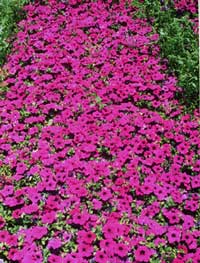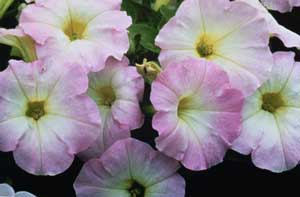 |
January
Petunia Design - Grandma's purple petunias are not just purple anymore. When you think about this year's garden remember that petunias now come in purple, red, rose, fuchsia, lavender, blue, pink, and even yellow. You can buy varieties that will not grow taller than 6 to 8 inches, some that will grow 8 to 12 inches and some giants that might go as high as two feet; lots of choices now.
February
Petunia Design – While daydreaming about having sun and a garden again in a few months, remember petunias work well in beds, as borders, and in containers, window boxes, and hanging baskets. Some petunias have a lovely fragrance.
Container design idea from Proven Winners for spring to early summer - In a medium to large container combine two each of Ageratum 'Artist Purple', Licorice Plant 'Petite Licorice', and Petunia 'Supertunia Priscilla. For more combinations see www.provenwinners.com.
Another combination would be 'Silver Wave' with 'Blackie' Sweet potato vine and purple fountain grass. Try Black-Eyed Susans with yellow or white petunias.
 |
March
Petunia Care - While you can grow petunias from seed, we recommend transplants from the garden center as the best way to start. Instructions for starting Petunia seed are found at the end of this section. Plant Petunia seedlings as soon as danger of frost is past and the soil is warm, probably next month. Remember to "harden" your transplants before planting them in the soil. See yardener.com for advice about hardening off transplants; key words “hardening off”.
Petunia Design - Be careful to check on how large a plant your petunia will become. The relatively new 'Wave" series will come in a 4 inch pot, but when fully grown will cover a six foot circle with gorgeous and continuous color.
April
Petunia – Plant petunia seedlings where they will get lots of sun, at least half a day. While they will bloom in bright, indirect light, they do their best in sun. They like fertile soil which drains well and is neutral to slightly acid (pH 6.0 to 7.0). Light, sandy soil is ideal.
Choose compact, healthy transplants with firm buds along with the blossoms. Keep their soil moist until planting time. While petunias are one of the few plants which can handle bright sun as newly planted seedlings, it is best to choose a late afternoon or overcast day to plant. Prepare the soil after it has dried out enough to be workable and all danger of frost is past. Ideally, the soil temperature should be over 60F.
While not required, Petunias give a better show if planted in groups of at least three. Space grandifloras and multifloras about twelve inches apart,. The compact miniature milliflora petunias can be spaced as close as four to six inches, but the new spreading ground-cover types of petunias (Wave petunias) should be planted at least one and a half feet apart.
After seedlings have grown to 6 inches tall, pinch back their central stems to force the petunia plants to develop side stems and become bushy.
In containers - Petunias can be planted more closely together in containers or hanging baskets in order to look attractively full right from the start. You can thin out plants later if the container gets overcrowded.
May
Petunia - Petunias are heavy feeders. When planting transplants in the soil or in containers, add some slow release granular fertilizer according to the label instructions. You will be offering more fertilizer each month throughout the growing season.
Optional task – Petunias grow best when mulched. As soon as the Petunia seedlings are tall enough, spread a 2 or 3 inch layer of some organic material such as chopped leaves, dried grass or wood chips on the soil around the plants.
June
Petunia Care – Your petunias will start blooming this month and last through to the first frost. Most of the new varieties of petunia need no deadheading as their predecessors did back in the 80’s and earlier. These modern petunias are more compact, tolerate wet weather and are self-cleaning. However, petunias growing in containers can be kept neater by pinching scraggly stems as they begin to develop over the season.
Petunias in the soil or in containers need fertilizing 4 or 5 times a season or about every two to three weeks. Use a diluted liquid fertilizer as a spray or a drench.
Petunias can be clipped to be added to fresh floral arrangements almost any time in the growing season. Float a blossom in a wine glass for a nice display. Petunia blossoms can also be dried.
July
Petunia – Petunias are shallow rooted so can dry out fairly quickly in the heat of the summer, so keep an eye out for any wilting and keep them watered. Petunias in containers may need water every day or sometimes twice a day; keep a close watch.
Optional - Most newer varieties of petunia can handle the heat just fine. However, if by mid-summer your plants begin to get leggy and the spindly stems produce fewer and smaller flowers, cut back each stem by half. While it seems drastic and may interrupt their blooming for 3 or 4 weeks, this procedure will revitalize them and they will produce an abundance of flowers until frost. While your plants are recovering from this haircut, move them to a spot where they get some afternoon shade to ease their stress. Next year buy newer varieties that do not need any pruning in the heat.
Optional – Your Petunias in the ground or in containers will appreciate a light feeding of fertilizer using a liquid fertilizer diluted to half strength according to the label. This can be poured into the soil or sprayed right on to the plant.
August
Petunia - This plant attracts hummingbirds. Petunias do not like to get too dry in the heat of summer. Keep them watered along with your other garden plants when rain is sporadic. Containers might need water once or even twice a day in high heat.
September
Petunia - Your petunia plants that got droopy in the heat of August should be coming back to their perky best as the temperatures cool off a bit.
October
Petunia - Your petunias will die with the first frost. Simply remove the dead plants and leave a layer of organic mulch over the soil so it is easily planted next spring. If you had a variety you particularly liked, save the little plastic plant label in a special place so you can refer to it next spring when you are buying new petunias.
Optional – If you have some petunias in containers or a hanging basket that can accommodated inside your home, you can bring those plants indoors a few weeks before you expect a frost. Place these containers where they will get good light and even some sun. You should have blooms brightening up your home for another month at least.
Propagating Petunias
Propagating Petunias
There are many, many kinds of petunias available as seedlings in the spring in local garden centers, nurseries and home centers. However, if you wish to have a certain type or color that is not available you can grow them yourself. Be advised that growing seedlings is something of an art and takes some knowledge and equipment to produce sturdy, healthy plants.
Petunia seeds are notoriously slow to germinate, so start them ahead indoors rather outdoors in the garden in order to have seedlings ready to put out in the yard when warm weather arrives. They are also very tiny, so sometimes it is easiest to mix them with some dry sand so that they spread evenly when sprinkled on the growing medium. Six to eight weeks before the date of the last expected frost in your area fill 2 inch deep flat boxes or peat pots with moist seed starter mix or soilless potting mix which are available at garden centers. After sowing the seeds, press down lightly on them to be sure they are in contact with the growing medium. Do not cover them with soil, because they need light to germinate. Water them from below so that they are not disturbed. They will germinate in 5 to 15 days at normal indoor house temperatures. For optimum growth, place seedlings under fluorescent lights for 12 hours daily to simulate late spring light conditions.
See Starting Plants From Seed and see Seed Starting Supplies and Equipment.

